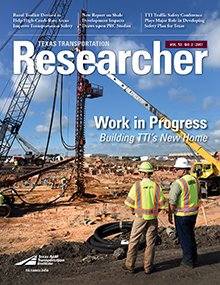As travel pattern data collection techniques continue to evolve, Texas A&M Transportation Institute (TTI) researchers have completed numerous leading-edge studies over the past several years that compare travel data collected from cellphones, GPS and Bluetooth® sources to determine which technology works best for collecting origin-destination (O-D) data for different types of transportation studies.

An O-D study is used to identify travel patterns and movements of traffic during specified time periods such as on weekdays, weekends or peak travel periods, or even during major events. O-D data provide critical information for routing and alignment studies and long-range transportation planning, especially in areas facing substantial growth.
The methods and practice of collecting and analyzing O-D data using cell, GPS and Bluetooth® are still evolving. While significant strides have been made, uncertainties still remain about the capabilities and limitations of each technology, how they compare, and which technology (or combination of technologies) is best suited for different types of O-D studies.
“The data from these technologies have transformed the way information on O-D and travel patterns is collected and estimated,” says TTI Transportation Planning Program Manager Ed Hard. “In our research, we compared the capabilities and attributes of each technology to determine how well they collect O-D data for different distances, durations and geographic scales such as large metropolitan regions versus smaller urban areas. By doing this, we were able to establish some general guidelines on the suitability of each technology in relation to different types of O-D studies.”
For example, planning studies focus more on O-D matrices of travel between zones in an urban area, so detailed accuracy to determine the routes used isn’t necessary. For these types of studies, cell data are generally best. On the other hand, a routing study to determine where traffic on a section of freeway is coming from and going to would probably need GPS data, where positional accuracy is much better than that from cell data.
The results of the research, which was sponsored by the Texas Department of Transportation and the Federal Highway Administration’s Travel Model Improvement Program, yielded a synopsis intended to serve as a quick reference tool outlining which data source to use for each type of O-D study.
“This research is among the first in the country to provide benchmarking and validation for O-D estimates derived from cell, GPS and Bluetooth technologies,” explains Hard. “Within the past few years, state and local transportation agencies have begun to purchase new technology O-D data from private-sector data aggregators, but there hasn’t been any guidance on which type of data is best for different applications, and that’s what we’ve been able to provide.”
